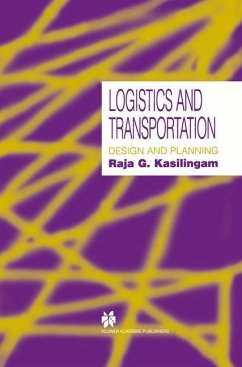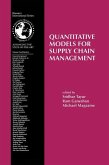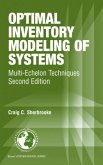- Broschiertes Buch
- Merkliste
- Auf die Merkliste
- Bewerten Bewerten
- Teilen
- Produkt teilen
- Produkterinnerung
- Produkterinnerung
Industrial Assembly is a rapidly changing field with significant importance in production. This book is the first of its kind to combine technology, design, methods, and planning and control models of assembly operations and systems. With the increasing importance of assembly in industry and of simultaneous engineering approaches, this timely publication provides: comprehensive coverage of technological, engineering, and management aspects of this field; multi-disciplinary approaches to rationalization of assembly operations and systems; explanation of qualitative models, information…mehr
Andere Kunden interessierten sich auch für
![Logistics and Transportation Logistics and Transportation]() Raja G. KasilingamLogistics and Transportation116,99 €
Raja G. KasilingamLogistics and Transportation116,99 €![Handbook of Total Quality Management Handbook of Total Quality Management]() Handbook of Total Quality Management155,99 €
Handbook of Total Quality Management155,99 €![Quantitative Models for Supply Chain Management Quantitative Models for Supply Chain Management]() Quantitative Models for Supply Chain Management232,99 €
Quantitative Models for Supply Chain Management232,99 €![Re-engineering the Enterprise Re-engineering the Enterprise]() Re-engineering the Enterprise116,99 €
Re-engineering the Enterprise116,99 €![Strategic Decision Making in Modern Manufacturing Strategic Decision Making in Modern Manufacturing]() Harinder Singh JagdevStrategic Decision Making in Modern Manufacturing39,99 €
Harinder Singh JagdevStrategic Decision Making in Modern Manufacturing39,99 €![Optimal Inventory Modeling of Systems Optimal Inventory Modeling of Systems]() Craig C. SherbrookeOptimal Inventory Modeling of Systems216,99 €
Craig C. SherbrookeOptimal Inventory Modeling of Systems216,99 €![Practical Applications of Fuzzy Technologies Practical Applications of Fuzzy Technologies]() Practical Applications of Fuzzy Technologies155,99 €
Practical Applications of Fuzzy Technologies155,99 €-
-
-
Industrial Assembly is a rapidly changing field with significant importance in production. This book is the first of its kind to combine technology, design, methods, and planning and control models of assembly operations and systems. With the increasing importance of assembly in industry and of simultaneous engineering approaches, this timely publication provides: comprehensive coverage of technological, engineering, and management aspects of this field; multi-disciplinary approaches to rationalization of assembly operations and systems; explanation of qualitative models, information technologies, and design techniques, which have been practised effectively in industrial assembly; as well as theoretical foundations and emerging trends that shape the future of assembly.
Produktdetails
- Produktdetails
- Verlag: Springer / Springer US / Springer, Berlin
- Artikelnr. des Verlages: 978-1-4613-7937-9
- Softcover reprint of the original 1st ed. 1997
- Seitenzahl: 516
- Erscheinungstermin: 2. November 2012
- Englisch
- Abmessung: 235mm x 155mm x 28mm
- Gewicht: 774g
- ISBN-13: 9781461379379
- ISBN-10: 1461379377
- Artikelnr.: 39503354
- Herstellerkennzeichnung Die Herstellerinformationen sind derzeit nicht verfügbar.
- Verlag: Springer / Springer US / Springer, Berlin
- Artikelnr. des Verlages: 978-1-4613-7937-9
- Softcover reprint of the original 1st ed. 1997
- Seitenzahl: 516
- Erscheinungstermin: 2. November 2012
- Englisch
- Abmessung: 235mm x 155mm x 28mm
- Gewicht: 774g
- ISBN-13: 9781461379379
- ISBN-10: 1461379377
- Artikelnr.: 39503354
- Herstellerkennzeichnung Die Herstellerinformationen sind derzeit nicht verfügbar.
1 Introduction and fundamental concepts of assembly.- 1.1Introduction.- 1.2Nature and role of assembly in industry.- 1.3 The economic significance of assembly.- 1.4 Assembly engineering and rationalization.- 1.5 Management issues and assembly organizations.- 1.6 General taxonomy of assembly operations and systems.- 1.7 Assembly information representation.- 1.8 Fundamental models and measures of assembly.- 1.9 Assembly planning issues.- 1.10 Summary.- 1.11 Review questions.- References.- 2 Assembly tasks and technology.- 2.1 Introduction.- 2.2 Levels of automation and flexibility in assembly.- 2.3 Assembly tasks.- 2.4 Disassembly tasks.- 2.5 Insertion and joining tasks.- 2.6 Summary.- 2.7 Review questions.- References.- 3 Design for assembly.- 3.1 Introduction.- 3.2 Product design for assembly.- 3.3 Group technology for assembly.- 3.4 Procedural systems for assemblability evaluation.- 3.5 Design for disassembly and recycling.- 3.6 Computer-aided methods for DFA.- 3.7 Artificial intelligence approaches to DFA.- 3.8 Summary.- 3.9 Review questions.- References.- 4 Design of assembly systems.- 4.1 Introduction.- 4.2 The planning of an assembly system.- 4.3 Assembly organization.- 4.4 Handling facilities.- 4.5 Machines for assembly automation.- 4.6 Economic justification of assembly systems.- 4.7 Examples of assembly systems.- 4.8 Summary.- 4.9 Review questions.- References.- 5 Assembly system design and planning.- 5.1 Introduction.- 5.2 Assembly line balancing.- 5.3 Assembly system design.- 5.4 Process planning in assembly.- 5.5 Sequence planning for robotic assembly.- 5.6 Summary.- 5.7 Review questions.- References.- 6 Performance evaluation of stochastic assembly systems.- 6.1 Introduction.- 6.2 Push systems.- 6.3 Pull systems.- 6.4 Flexible assembly systems.- 6.5 Simulation analysis.- 6.6 Summary.- 6.7 Review questions.- References.- 7 Sequencing and scheduling of assembly operations.- 7.1 Introduction.- 7.2 Scheduling in push systems.- 7.3 Level scheduling in just-in-time pull systems.- 7.4 Sequencing in mixed-model assembly lines.- 7.5 Summary.- 7.6 Review questions.- References.- 8 Time-managed material flow control.- 8.1 Introduction.- 8.2 The kitting process.- 8.3 Recursion models for repetitive assembly.- 8.4 Optimal time management.- 8.5 Summary.- 8.6 Review questions.- References.- 9 Quality and inspection in assembly.- 9.1 Introduction.- 9.2 Quality issues related to assembly.- 9.3 Inspection and test during assembly.- 9.4 Rework and repair in assembly.- 9.5 Error diagnosis and recovery in assembly.- 9.6 Communication and integration of assembly and inspection.- 9.7 Summary.- 9.8 Review questions.- References.- 10 Emerging trends in assembly.- 10.1 Introduction.- 10.2 Emerging trends in assembly technology.- 10.3 Emerging trends in the design of products and systems.- 10.4 Assembly utilities.- 10.5 The influence of emerging information technologies.- 10.6 Research issues in assembly.- 10.7 Summary.- 10.8 Review questions.- References.
1 Introduction and fundamental concepts of assembly.- 1.1Introduction.- 1.2Nature and role of assembly in industry.- 1.3 The economic significance of assembly.- 1.4 Assembly engineering and rationalization.- 1.5 Management issues and assembly organizations.- 1.6 General taxonomy of assembly operations and systems.- 1.7 Assembly information representation.- 1.8 Fundamental models and measures of assembly.- 1.9 Assembly planning issues.- 1.10 Summary.- 1.11 Review questions.- References.- 2 Assembly tasks and technology.- 2.1 Introduction.- 2.2 Levels of automation and flexibility in assembly.- 2.3 Assembly tasks.- 2.4 Disassembly tasks.- 2.5 Insertion and joining tasks.- 2.6 Summary.- 2.7 Review questions.- References.- 3 Design for assembly.- 3.1 Introduction.- 3.2 Product design for assembly.- 3.3 Group technology for assembly.- 3.4 Procedural systems for assemblability evaluation.- 3.5 Design for disassembly and recycling.- 3.6 Computer-aided methods for DFA.- 3.7 Artificial intelligence approaches to DFA.- 3.8 Summary.- 3.9 Review questions.- References.- 4 Design of assembly systems.- 4.1 Introduction.- 4.2 The planning of an assembly system.- 4.3 Assembly organization.- 4.4 Handling facilities.- 4.5 Machines for assembly automation.- 4.6 Economic justification of assembly systems.- 4.7 Examples of assembly systems.- 4.8 Summary.- 4.9 Review questions.- References.- 5 Assembly system design and planning.- 5.1 Introduction.- 5.2 Assembly line balancing.- 5.3 Assembly system design.- 5.4 Process planning in assembly.- 5.5 Sequence planning for robotic assembly.- 5.6 Summary.- 5.7 Review questions.- References.- 6 Performance evaluation of stochastic assembly systems.- 6.1 Introduction.- 6.2 Push systems.- 6.3 Pull systems.- 6.4 Flexible assembly systems.- 6.5 Simulation analysis.- 6.6 Summary.- 6.7 Review questions.- References.- 7 Sequencing and scheduling of assembly operations.- 7.1 Introduction.- 7.2 Scheduling in push systems.- 7.3 Level scheduling in just-in-time pull systems.- 7.4 Sequencing in mixed-model assembly lines.- 7.5 Summary.- 7.6 Review questions.- References.- 8 Time-managed material flow control.- 8.1 Introduction.- 8.2 The kitting process.- 8.3 Recursion models for repetitive assembly.- 8.4 Optimal time management.- 8.5 Summary.- 8.6 Review questions.- References.- 9 Quality and inspection in assembly.- 9.1 Introduction.- 9.2 Quality issues related to assembly.- 9.3 Inspection and test during assembly.- 9.4 Rework and repair in assembly.- 9.5 Error diagnosis and recovery in assembly.- 9.6 Communication and integration of assembly and inspection.- 9.7 Summary.- 9.8 Review questions.- References.- 10 Emerging trends in assembly.- 10.1 Introduction.- 10.2 Emerging trends in assembly technology.- 10.3 Emerging trends in the design of products and systems.- 10.4 Assembly utilities.- 10.5 The influence of emerging information technologies.- 10.6 Research issues in assembly.- 10.7 Summary.- 10.8 Review questions.- References.









